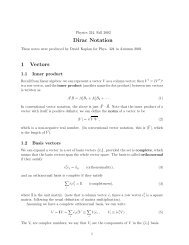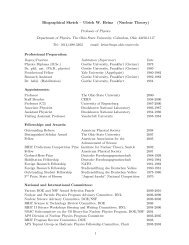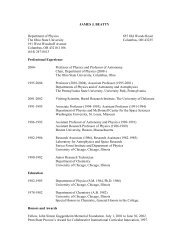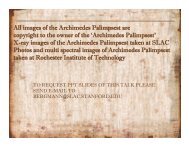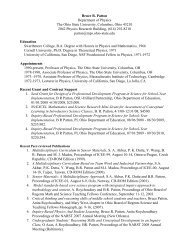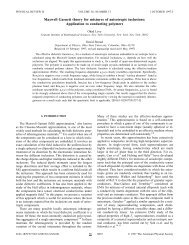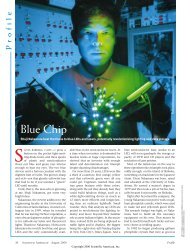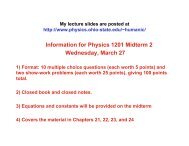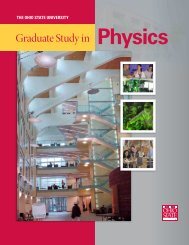Brasil Final Report - Department of Physics - The Ohio State University
Brasil Final Report - Department of Physics - The Ohio State University
Brasil Final Report - Department of Physics - The Ohio State University
Create successful ePaper yourself
Turn your PDF publications into a flip-book with our unique Google optimized e-Paper software.
26<br />
returned to the students. <strong>The</strong>y are expected to be able to answer the questions by working through<br />
the tutorials.) <strong>The</strong> post-tests require an understanding <strong>of</strong> the concepts covered in the tutorials.<br />
However, they are designed so that they cannot be answered on the basis <strong>of</strong> problems that students<br />
have memorized.<br />
In this paper, the data on student performance in introductory physics are from the calculusbased<br />
course. Results from the algebra-based course are similar. <strong>The</strong> pre- and post-test data from<br />
our university are supplemented by information obtained from pilot sites. This feedback helps us<br />
determine the effectiveness <strong>of</strong> the tutorials in different instructional settings and guides us in<br />
modifying the curriculum accordingly.<br />
Multiple-slit interference<br />
Ever since tutorials were introduced in the calculus-based physics course at the <strong>University</strong> <strong>of</strong><br />
Washington, all examinations have included qualitative problems related to topics from the tutorials.<br />
Student performance on these problems has been the most common form <strong>of</strong> assessment. Below we<br />
describe a set <strong>of</strong> pretest and post-test questions to assess the tutorials on double-slit and multipleslit<br />
interference.<br />
Pretest<br />
On the pretest, the students are shown the central portion <strong>of</strong> the pattern formed by light<br />
incident on a mask with two very narrow slits separated by a distance d. (See Fig. 5.) A point <strong>of</strong><br />
maximum intensity, B, is marked. <strong>The</strong> students are told that the two-slit mask is replaced by a<br />
three-slit mask with the same separation d between adjacent slits. <strong>The</strong>y are asked whether point B<br />
would still be a point <strong>of</strong> maximum constructive interference. This question requires application <strong>of</strong><br />
the ideas <strong>of</strong> path length difference and superposition. From the pattern, it can be seen that light<br />
from two slits a distance d apart is in phase at point B. Since the distance between adjacent slits in<br />
the three-slit mask is also d, light from all three slits is in phase at point B. [See Fig. 6(a).] Thus<br />
point B will still be a point <strong>of</strong> maximum constructive interference but brighter than before. This<br />
question was given to about 560 students, either before or after lecture instruction. Since the results<br />
were similar, the data have been combined in the first column <strong>of</strong> Table III.<br />
About 30% <strong>of</strong> the students have answered this question correctly. However, fewer than 5%<br />
have given correct reasoning. Most <strong>of</strong> the students have failed to consider path length differences<br />
and to reason in terms <strong>of</strong> superposition. About 60% <strong>of</strong> the participants in the graduate teaching<br />
seminar (N ≈ 55) have given the correct response. About 25% have given correct explanations. (See<br />
column 3 <strong>of</strong> Table III.)<br />
Post-test<br />
In one <strong>of</strong> the post-test questions, students are shown the same double-slit interference pattern<br />
as was used for the pretest. (See Fig. 5.) In this case, however, they are asked how the intensity at<br />
point B changes when a third slit is added a distance d/2 to the right <strong>of</strong> the rightmost slit. <strong>The</strong><br />
students need to recognize that the waves from the original two slits are in phase at point B. When<br />
the third slit is added, the waves from this slit are 180° out <strong>of</strong> phase with the waves from both <strong>of</strong><br />
the other slits. [See Fig. 6(b).] <strong>The</strong>refore, the intensity at point B decreases. This question requires<br />
students to extend their thinking to a situation beyond their experience, i.e., when the slits are not<br />
evenly spaced.<br />
<strong>The</strong> results <strong>of</strong> the post-test question are shown in the second column <strong>of</strong> Table III. About 80%




